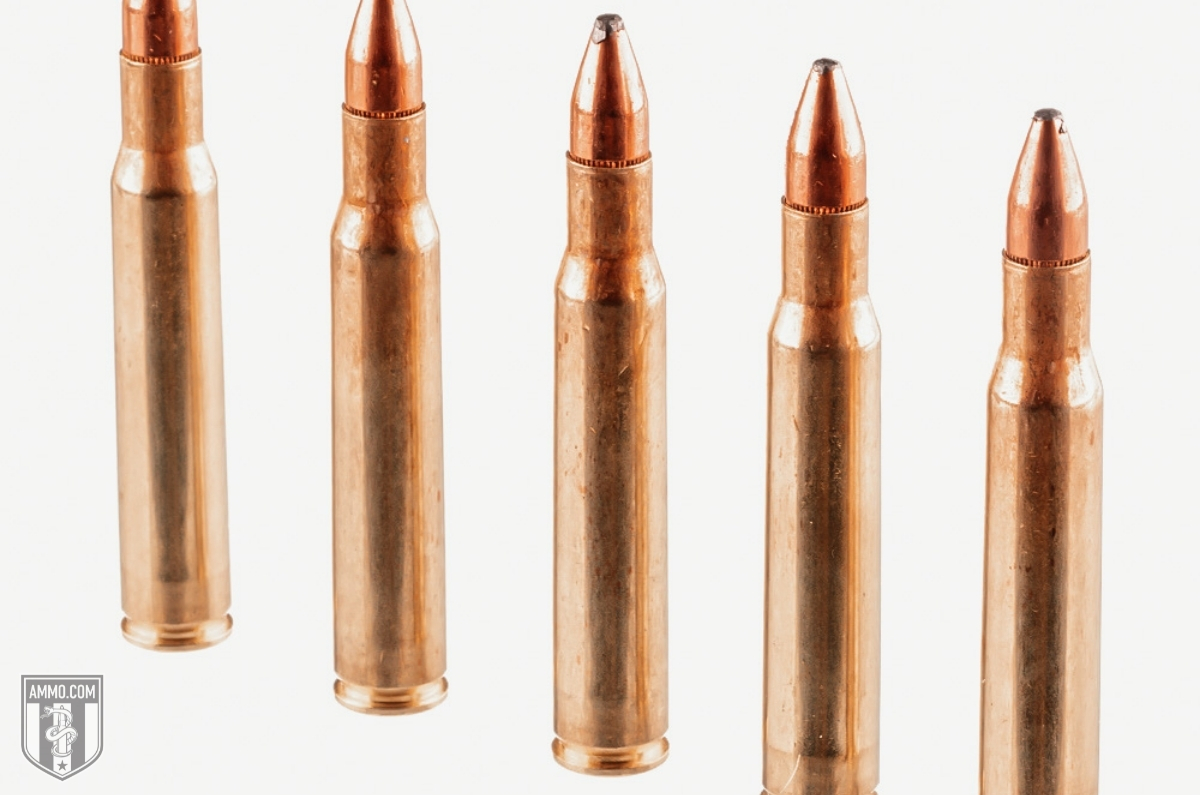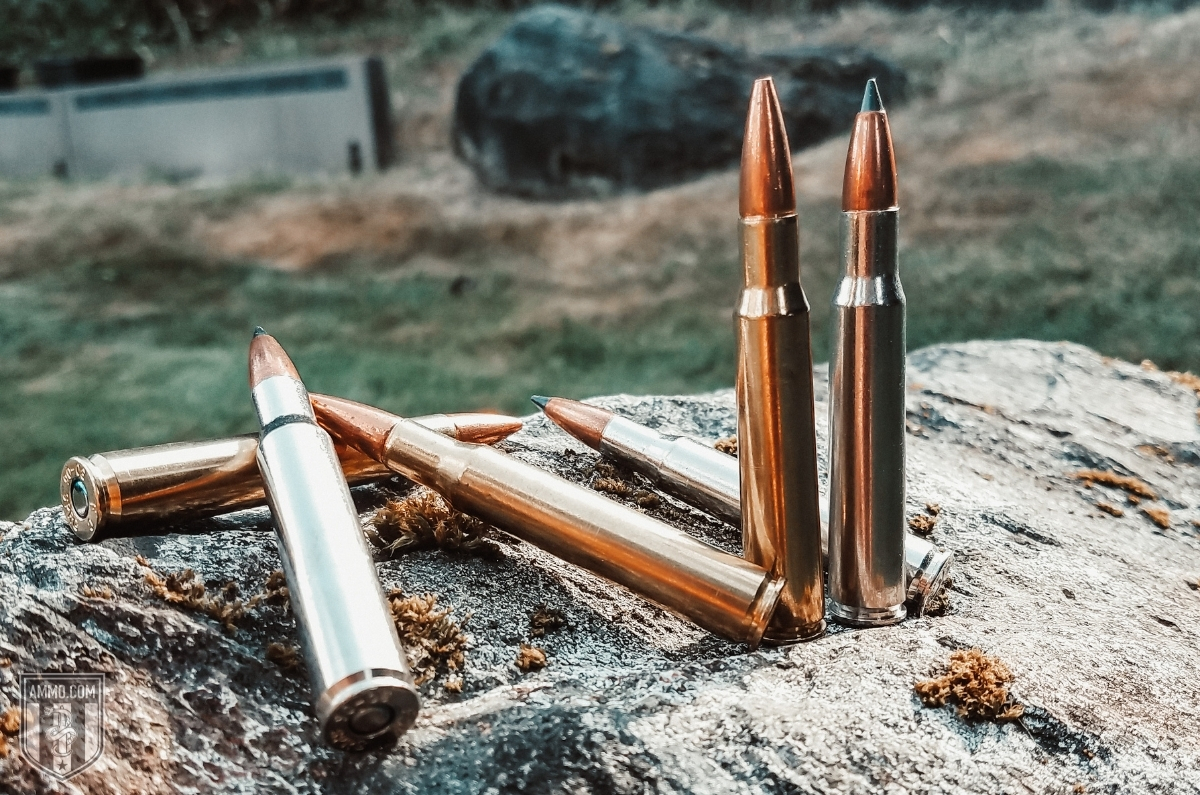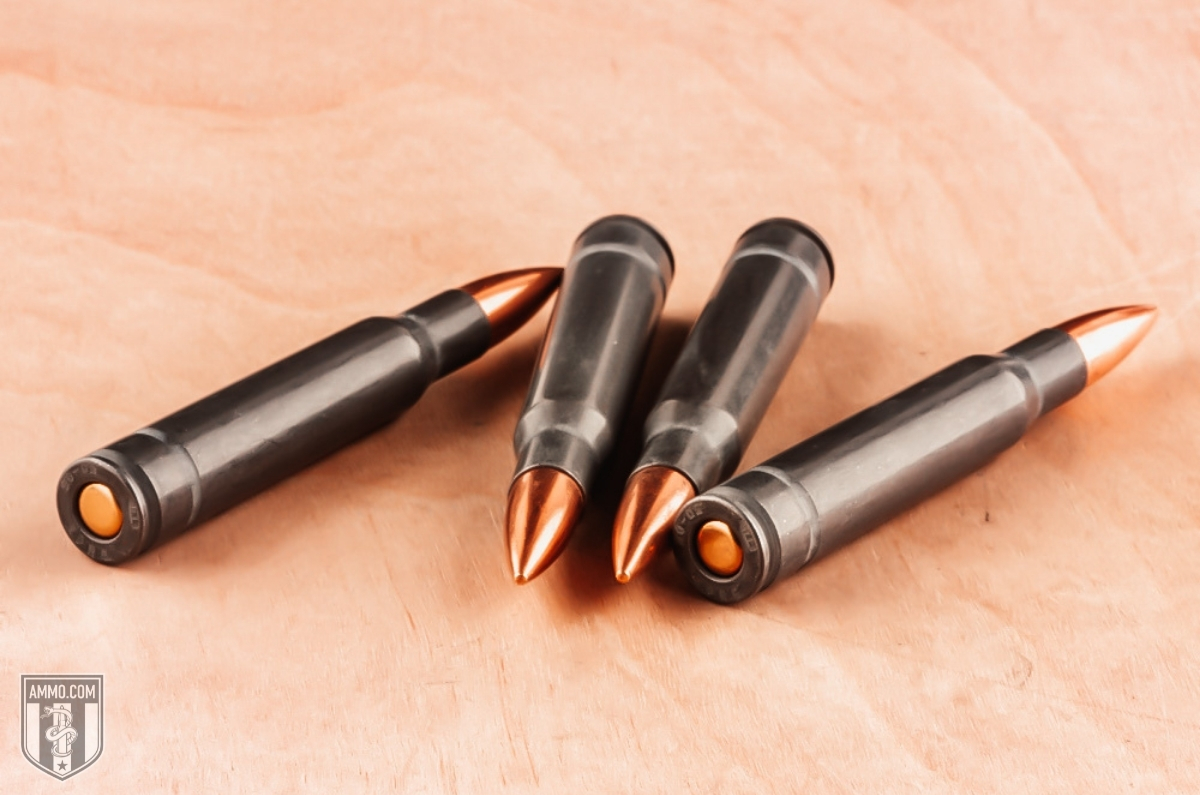308 vs 30-06: An All-American 30 Caliber Showdown
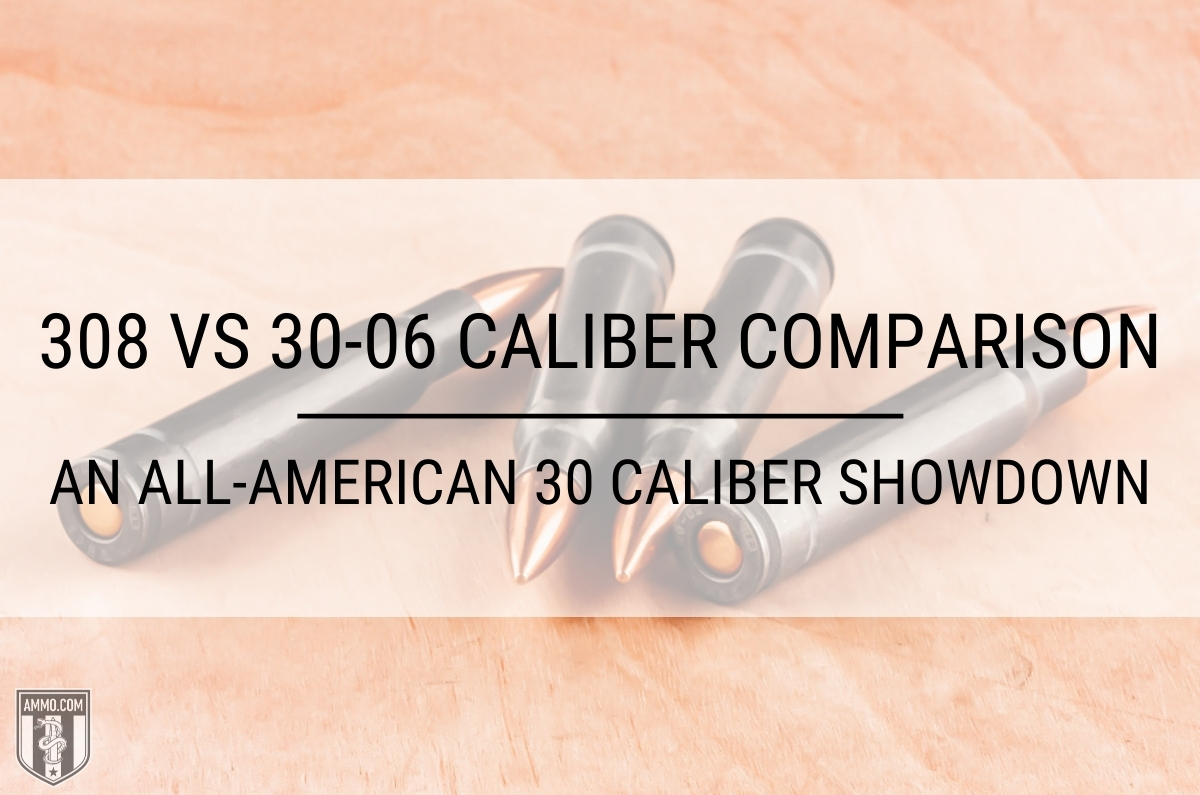
When it comes to the most iconic rifle cartridges developed by the U.S. Military that defined two generations, no one can debate that the 30-06 Springfield and the 308 Winchester are at the top of the list.
Not only have these two rifle cartridges served our troops faithfully overseas, but they are also two of the most popular hunting cartridges across North America and around the globe.
The debate over which cartridge is superior has been raging ever since the 308 usurped the service rifle throne in 1954 and has been a constant source of “friendly discussion” around internet forums, whitetail camps, and the National Matches ever since.
Does this debate REALLY need to happen? Let's take a look at the history, ballistics, and applications of both rifle cartridges to help you decide which one is best for you.
With that in mind, as they say at Camp Perry, “All-ready on the right! All-ready on the left! All-ready on the firing line…You may load and fire!”
The Difference Between .308 vs .30-06: The Bane of Tyrants and Black Bear Alike
Before we dig into the nitty-gritty details about the major differences between these two long-range shooting staples, it’s important to understand a little bit about the storied history of these two 30 caliber all-stars.
As the saying goes, “Age before beauty”. Let’s start with the stalwart 30-06 Springfield.
A Brief History of the 30-06 Springfield: America’s 30 Caliber Darling
America’s love affair with 30 caliber rifle rounds began all the way back in the Wild West with the introduction of the 30-30 Winchester. Later, the U.S. Army developed the 30-40 Krag to be its smokeless powder replacement for the .45-70 Government.
Around 1901, the U.S. Military started developing a new cartridge to replace the 30-40 Krag that was made famous by Theodore Roosevelt and his Rough Riders in the Spanish-American War.
At the time, heavier bullets were thought to be the superior choice. Therefore, the initial design in 1903 used the same 220-grain round nose bullets fired by the 30-40 Krag.
The 30-03 Springfield was patterned after the famous 7x57mm Mauser cartridge, sharing identical case head dimensions.
However, it didn’t take long for the American generals to take note that multiple European nations were favoring higher velocity, Spitzer (pointed) bullets in their new bolt action rifles.
Not wanting to get left behind, the U.S. Military was quick to adopt a similar design. In 1906, the new cartridge that fired a 150-grain Spitzer bullet was submitted and accepted.
Thus the 30-06 Springfield was born. The “30” designates the bullet caliber and the “06” (pronounced 'aught six') designates the year of its adoption.
Although the 30-06 initially gained popularity with the Army’s new bolt action rifle, the 1903 Springfield, it truly became World Famous with the introduction of the semi-auto M1 Garand during World War II.
The 30-06 Springfield was the ammo carried by our soldiers who fought in the trenches on the Western Front in World War I, stormed the beaches of Normandy in WWII, assaulted the 38th Parallel in Korea, and saw limited use in the jungles of Vietnam.
Not only has the 30-06 seen massive success on the battlefield but it has also been credited with claiming every large game animal in North America up to black bear.
The 30-06 is truly a rifle cartridge of American legend and has survived the test of time, as it is still one of the most popular hunting rounds in the world over 100 years later.
A Brief History of the .308 Winchester: A Challenger To The Throne
Following the end of the Korean War, the U.S. Military started developing a replacement for the storied M1 Garand.
Although the M1 Garand had served the U.S. Armed Forces valiantly through World War II and Korea, the military wanted a more modern service rifle with select-fire capability and detachable magazines similar to the Stg-44 and AK-47.
Even though the 30-06 Springfield had performed extremely well, the fact that it required a long action made it less desirable for a full auto service rifle.
The U.S. Military wanted a new cartridge that fired a 30-caliber bullet, a shorter case to fit into a short action, and ballistics that closely mimicked the 30-06. And with advancements in case design and new propellants, this was achievable.
What was finally accepted became known as the 7.62x51mm NATO or the 308 Winchester. Winchester was the first company to commercially market the new cartridge and they quickly adapted their Model 70 bolt action rifle to accept it.
It didn’t take long for the 308 Winchester to become one of the most popular large game hunting cartridges in North America.
And it didn’t stop there!
Competitive marksmen quickly discovered that the 308 was an extremely accurate cartridge and the 308 Winchester quickly started dominating long range shooting competitions. So much so that the NRA had to shrink the bullseye on their high-power rifle targets to avoid ties between 308 shooters.
Although the 308’s life as the U.S. Military’s service rifle cartridge was rather short, being replaced by the 5.56x45mm NATO (223 Remington), it is still utilized by designated marksmen and snipers for its supreme accuracy and stopping power. However, this is also coming into question with the rise of the 6.5 Creedmoor and the 300 Winchester Magnum.
.30-06 vs .308: The Comparison
To start the comparisons, let's take a closer look at the dimensions and specifications of each of these superb long-range shooting rifle cartridges.
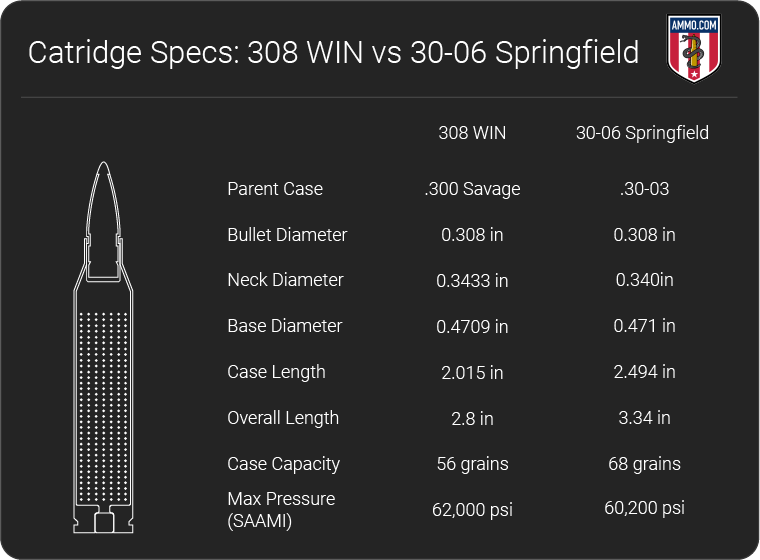
The first thing you’ll note is that both the 30-06 and the 308 shoot the same caliber bullets, .308”, however, this is where the similarities end.
The first distinct difference is in the case length of each cartridge. The 308 Winchester has a shorter case length 2.015” while the 30-06 Springfield has a longer case length at 2.494”. The overall length of each cartridge is also quite different, 2.8” vs 3.34” for the 308 and Winchester 30-06 ammo respectively.
This difference in case length and overall length is why the 30-06 requires a long action while the 308 fits into a short action.
A short action will have a shorter bolt throw (in a bolt action rifle) and requires less movement when chambering a round. Short action rifles are often preferred as they allow for quicker follow up shots and are believed to have a tighter, stronger receiver which increases accuracy and decreases overall weight.
The next massive difference between these two rifle cartridges is their case capacity. The 30-06 has a case capacity of 68 gr H2O while the 308 measures in at 58 gr H2O. This makes a lot of sense as a 30-06 has an almost 0.5” longer case.
Simply put, the 30-06 is a bigger, bulkier cartridge…but how does that apply to which ammo you should be loading into your sporting rifle? Let’s take a look!
.308 vs .30-06: Recoil
Both the 308 Winchester and the 30-06 Springfield are considered to have a manageable recoil impulse (though if you’re used to shooting .22 LR or 223 Remington you might disagree with me).
That being said, neither cartridge is a slouch when it comes to recoil and you’ll need to use proper shooting form and cheek weld to ensure accuracy.
As the 308 has a shorter case and therefore a lower case capacity, it will have less recoil than the 30-06.
But how much are we talking about?
There’s a wide variety of bullet weights that you can choose from when shooting either cartridge, which will greatly affect the felt recoil. Furthermore, rifle weight also plays a part in how hard your shoulder gets pounded when you pull the bang switch.
However, on average the 308 has a felt recoil of about 21 ft/lb while the 30-06 averages in around 23 ft/lb of shoulder punishment.
The next logical question is, does this really matter? Well, it can.
Less recoil will make it easier to develop good shooting practices and not anticipate recoil. This can translate into increased accuracy downrange.
This gives the 308 a slight edge in terms of recoil.
.308 vs .30-06: Accuracy
This is a heavily debated topic in the shooting community as both rifle cartridges have their camps that proclaim theirs is the superior choice for accuracy.
In the early days, I will concede that the 308 was the more accurate cartridge choice due to the use of a short action.
Short action rifles will have tighter construction and should result in a more rigid shooting platform. And this was reflected in the initial competitive results.
But is that true today? Not so much.
Rifle construction has come a long way since the 1950s and in modern sporting rifles, it's highly unlikely that you’ll be able to discern and difference in accuracy between 308 and 30-06.
Check out our recommendations for the best 30-06 ammo for accuracy!.308 vs .30-06: Ammo Price
Ammo cost is always a consideration when you’re looking to purchase a new hunting rifle or target shooting platform.
In general, the 308 will be the cheaper ammo to buy as it has less material involved in the construction, both in the case and volume of propellant used.
Buying in bulk is always smart, make sure to check out our stock of bulk 308 ammo.
Let’s take a look at a popular hunting round you can purchase here on Ammo.com, the Remington 180 gr PSP. (Please note that all ammo price quotes in this article are correct at the time of writing and can change due to market conditions and supply/demand)
For the 308 Remmington ammo, you’ll be paying about $1.60/round while the 30-06 Remington ammo will cost you roughly $2.10/round.
For more ammo options, check out our Remington .30-06 ammo page.
Now if you’re only shooting a few boxes a year to confirm your zero and go Whitetail hunting, that difference in cost probably isn’t going to mean all that much. But if you’re a competitive shooter and go through a lot of ammo each year, that cost can add a lot to your shooting budget.
As it stands, the 308 is the cheaper ammo to buy.
.308 vs .30-06: Rifle Availability
Since their development, both of these cartridges have been extremely popular with long-range shooters and hunters alike.
As such, there is a wide variety of sporting rifles available in both cartridges to fit your needs and budget.
If you’re looking for big game hunting you need to look no further than a Savage 110, Ruger Hawkeye, Remington 700, or Winchester Model 70.
If you’re on a budget then a Savage Axis or Ruger American will fit the bill, you can even pick up a converted Mauser on the cheap if you know where to look.
However, if you are in the market for a semi-auto then the 308 is where you should be looking. Semi-automatic rifles chambered in 308 are considerably more plentiful than 30-06.
You can easily pick up an AR-10, FN-FAL, CETME, or M1A chambered in 308 to cover all your semi-auto plinking needs. For the 30-06, you’re mostly limited to the M1 Garand when it comes to semi-automatic fire.
.30-06 vs .308: Deer Hunting
And now we come to the topic that ignites most debate among hunters. Which of these two hunting cartridges is better?
With a wide variety of bullet weights, both the 308 and the 30-06 Springfield can handle most of your big game hunting needs up to black bear.
Both hunting rounds can accept bullet weights from 150 to 200 grains. However, the 30-06 has one specific advantage in its ability to accept 220-grain bullets.
With its longer case, increased case capacity, and long action, the 30-06 can accommodate these heavier bullets while the 308 tops out at 200 gr.
Furthermore, increased case capacity will translate to a higher muzzle velocity (fps) for the 30-06, usually in the range of about 150 to 200 fps more than the 308.
Does that matter? When you’re deer hunting I doubt the Whitetail or Mule Deer is going to be able to tell the difference.
For a large game animal, it can make a difference. Let’s talk about elk specifically next.
.308 vs .30-06: Elk Hunting
Deer hunting is one thing, taking on a bull elk is something a bit different. That being said, both of these hunting rounds are capable of ethically harvesting a bull elk.
However, the ability to shoot heavier bullets at a higher velocity leads to the 30-06 having a slight edge when it comes to elk.
The 30-06 is simply going to penetrate more effectively (higher sectional density), which means it should punch through those thick elk bones and sinew easier than a 308.
However, shot placement is always key to a clean kill on an elk. A 220-grain bullet to the hindquarter from a 30-06 is going to be considerably less lethal than a 200-grain bullet to the lungs from a 308.
All things being equal, the 30-06 will be slightly more effective against elk (and bears) due to its greater stopping power, muzzle velocity, and better penetration.
.308 vs .30-06: Size
For this category, there simply is no contest as the 308 Winchester is the lighter option. And this applies to both the ammo and the rifle itself.
Short action rifles are going to have a shorter overall length and weigh less when compared to their long action counterparts.
With modern construction, this weight difference can be in terms of ounces. However, any backpacker will tell you that, “Ounces equal pounds”.
If you’re planning on hoofing that hunting rifle through the backwoods, your feet and back will thank you when you decide to bring your 308.
.308 vs .30-06: Long Range
This is another hotly contested point in the long-range target shooting community. Which is the more accurate cartridge?
On paper, the 30-06 “should” be the superior long-range cartridge.
It has a greater case capacity which will lead to a higher muzzle velocity and the ability to shoot heavier bullets that have a higher ballistic coefficient. Therefore, the 30-06 “should” just crush the NRA High Power Competitions, right?
This is a case where theory does not coincide with what we see downrange.
The simple truth is that the 308 can do everything the 30-06 can do at long range with less recoil. And as we’ve discussed, less recoil leads to enhanced accuracy and better shooting fundamentals.
Simply put, the 308 is a more efficient cartridge and you do not gain much (if any) advantage when you switch to 30-06.
For this reason, I doubt you are going to see the 30-06 lining up next to the 308, the 300 Winchester Magnum, and the 6.5 Creedmoor at your next NRA High Power match.
.30-06 vs .308: Reloading
If you’re a reloader like me, you’re going to love both the 308 Winchester and the 30-06 Springfield.
With a wide variety of bullet weights and propellants to chose from, both of these cartridges are a breeze to handload.
Furthermore, since they both use the same caliber bullets and primers, it’s easy to stockpile components for each if you are fortunate enough to have both in your collection.
If you’re looking to reload for a popular hunting bullet, then the Hornady 308 ammo InterLock SP or the Nosler Partition are great options to claim that trophy buck that’s been teasing you on your trail cams.
For really dialing in the FPS and milking out every MOA of accuracy then you might want to consider the Hornady 178 gr BTHP Match or the Nosler 168 gr HPBT Custom Competition to bore out the X-ring.
The 308 and the 30-06 are the dreams of every reloader out there who enjoys really tailoring their cartridges to maximize their potential.
.308 vs .30-06: Ballistics
Our team here at Ammo.com has put together some amazing ballistics tables for you to check out.
This lets you easily compare/contrast some of your favorite rounds from each cartridge and compare them in terms of muzzle velocity (fps), energy, and bullet drop from 0 to 400 yards.
These tables can give you an idea of the differences between these two 30 caliber powerhouses.
.30-06 Springfield Ballistics
Note: This information comes from the manufacturer and is for informational purposes only. The actual ballistics obtained with your firearm can vary considerably from the advertised ballistics. Also, ballistics can vary from lot to lot with the same brand and type load.
| 30-06 Bullet WEIGHT | Muzzle VELOCITY (fps) | Muzzle ENERGY (ft. lbs.) | TRAJECTORY (in.) | |||||||||||
|---|---|---|---|---|---|---|---|---|---|---|---|---|---|---|
| Muzzle | 100 yds. | 200 yds. | 300 yds. | 400 yds. | Muzzle | 100 yds. | 200 yds. | 300 yds. | 400 yds. | 100 yds. | 200 yds. | 300 yds. | 400 yds. | |
| 55 Grain | 4080 | 3485 | 2965 | 2502 | 2083 | 2033 | 1483 | 1074 | 764 | 530 | 2 | 1.9 | -2.1 | -11.7 |
| 125 Grain | 2660 | 2335 | 2034 | 1757 | n/a | 1964 | 1513 | 1148 | 856 | n/a | 0 | -5.2 | -18.9 | 0 |
| 125 Grain | 2700 | 2412 | 2143 | 1891 | 1660 | 2023 | 1615 | 1274 | 993 | 765 | 2.3 | 0 | -9.9 | -29.5 |
| 125 Grain | 3140 | 2780 | 2447 | 2138 | 1853 | 2736 | 2145 | 1662 | 1279 | 953 | 2 | 1 | -6.2 | -21 |
| 150 Grain | 2910 | 2617 | 2342 | 2083 | 1853 | 2820 | 2281 | 1827 | 1445 | 1135 | 2.5 | 0.8 | -7.2 | -23.4 |
| 150 Grain | 3080 | 2848 | 2617 | 2417 | 2216 | 3159 | 2700 | 2298 | 1945 | 1636 | 1.4 | 0 | -6.4 | -18.9 |
| 165 Grain | 2800 | 2534 | 2283 | 2047 | 1825 | 2872 | 2352 | 1909 | 1534 | 1220 | 2.5 | 0.4 | -8.4 | -25.5 |
| 168 Grain | 2710 | 2522 | 2346 | 2169 | 2003 | 2739 | 2372 | 2045 | 1754 | 1497 | 2.5 | 0.4 | -8 | -23.5 |
| 168 Grain M1 Garand | 2710 | 2523 | 2343 | 2171 | 2006 | 2739 | 2374 | 2048 | 1758 | 1501 | 2.3 | 0 | -8.6 | -24.6 |
| 170 Grain | 2000 | 1740 | 1510 | n/a | n/a | 1510 | 1145 | 860 | n/a | n/a | 0 | 0 | 0 | 0 |
| 178 Grain | 2720 | 2511 | 2311 | 2121 | 1939 | 2924 | 2491 | 2111 | 1777 | 1486 | 2.5 | 0.4 | -8.2 | -24.6 |
| 180 Grain | 2700 | 2469 | 2250 | 2042 | 1846 | 2913 | 2436 | 2023 | 1666 | 1362 | -2.5 | 0 | -9.3 | -27 |
| 180 Grain Superformance | 2820 | 2630 | 2447 | 2272 | 2104 | 3178 | 2764 | 2393 | 2063 | 1769 | 1.8 | 0 | -7.6 | -21.9 |
| 180 Grain High Energy | 2880 | 2690 | 2500 | 2320 | 2150 | 3315 | 2880 | 2495 | 2150 | 1845 | 1.7 | 0 | -7.2 | -21 |
| 220 Grain | 2410 | 2130 | 1870 | 1632 | 1422 | 2837 | 2216 | 1708 | 1301 | 988 | 2.5 | -1.7 | -18 | 0 |
.308 Ballistics
Note: This information comes from the manufacturer and is for informational purposes only. The actual ballistics obtained with your firearm can vary considerably from the advertised ballistics. Also, ballistics can vary from lot to lot with the same brand and type load.
| 308 Winchester Bullet WEIGHT | Muzzle VELOCITY (fps) | Muzzle ENERGY (ft. lbs.) | TRAJECTORY (in.) | |||||||||||
|---|---|---|---|---|---|---|---|---|---|---|---|---|---|---|
| Muzzle | 100 yds. | 200 yds. | 300 yds. | 400 yds. | Muzzle | 100 yds. | 200 yds. | 300 yds. | 400 yds. | 100 yds. | 200 yds. | 300 yds. | 400 yds. | |
| 55 Grain | 3770 | 3215 | 2726 | 2286 | 1888 | 1735 | 1262 | 907 | 638 | 435 | -2 | 1.4 | -3.8 | -15.8 |
| 110 Grain | 3165 | 2830 | 2520 | 2230 | 1960 | 2447 | 1956 | 1551 | 1215 | 938 | 1.4 | 0 | -6.9 | -20.9 |
| 120 Grain | 2850 | 2497 | 2171 | n/a | n/a | 2164 | 1662 | 1256 | n/a | n/a | 0 | -2.8 | n/a | n/a |
| 150 Grain | 2820 | 2533 | 2263 | 2009 | 1774 | 2648 | 2137 | 1705 | 1344 | 1048 | 2.5 | 0.4 | -8.5 | -26.1 |
| 150 Grain Superformance | 3000 | 2772 | 2555 | 2348 | 1962 | 2997 | 2558 | 2173 | 1836 | 1540 | 1.5 | 0 | -6.9 | -20 |
| 155 Grain | 2775 | 2553 | 2342 | 2141 | 1950 | 2650 | 2243 | 1887 | 1577 | 1308 | 1.9 | 0 | -8.3 | -24.2 |
| 155 Grain | 2850 | 2640 | 2438 | 2247 | 2064 | 2795 | 2398 | 2047 | 1737 | 1466 | 1.8 | 0 | -7.5 | -22.1 |
| 165 Grain | 2700 | 2440 | 2194 | 1963 | 1748 | 2670 | 2180 | 1763 | 1411 | 1199 | 2.5 | 0 | -9.7 | -28.5 |
| 168 Grain | 2680 | 2493 | 2314 | 2143 | 1979 | 2678 | 2318 | 1998 | 1713 | 1460 | 2.5 | 0 | -8.9 | -25.3 |
| 168 Grain Super Match | 2870 | 2647 | 2462 | 2284 | 2114 | 3008 | 2613 | 2261 | 1946 | 1667 | 1.7 | 0 | -7.5 | -21.6 |
| 170 Grain | 2000 | 1740 | 1510 | n/a | n/a | 1510 | 1145 | 860 | n/a | n/a | 0 | 0 | 0 | 0 |
| 178 Grain | 2620 | 2415 | 2220 | 2034 | 1857 | 2713 | 2306 | 1948 | 1635 | 1363 | 2.5 | 0 | -9.6 | -27.6 |
| 178 Grain Super Match | 2780 | 2609 | 2444 | 2285 | 2132 | 3054 | 2690 | 2361 | 2064 | 1797 | 1.8 | 0 | -7.6 | -21.9 |
| 180 Grain | 2620 | 2393 | 2178 | 1974 | 1782 | 2743 | 2288 | 1896 | 1557 | 1269 | 2.5 | -0.2 | -10.2 | -28.5 |
Conclusion
Although proponents of each of these phenomenal cartridges will proclaim victory for their chambering of choice, there simply isn’t a need for debate.
Both the 308 Winchester and the 30-06 Springfield are simply amazing rifle cartridges for target shooting and hunting alike and you should shoot what you like the best.
If you just love the deep, rich history that is engrained in every 30-06 round that you fire or you just can’t get enough of the tell-tale “PING” of the M1 Garand clip being ejected after round #8, then you crack off those 30-06 rounds to your heart's content.
Perhaps your father carried an M14 during Vietnam and swears by the efficiency of the 308, then you lock and load that M1A with pride and love every minute on the firing line.
Regardless of which rifle cartridge you choose, there’s not a game animal in North America that can tell the difference.
If you want my advice, get both!
I promise that you won’t be disappointed by either, you simply can’t go wrong with either of these All-American 30 caliber options.
Ammo Comparisons
- .308 vs 5.56
- 6.5 Creedmoor vs .308
- .300 Blackout vs .308
- .300 Win Mag vs .308
- .243 vs .308
- .308 vs .30-06
- 7mm-08 vs .308
- .270 vs .308
- 7.62x39 vs .308
- .223 vs .308
- .338 Lapua vs .308
- .380 ACP vs 9mm
- .223 vs 5.56
- .300 Blackout vs 5.56
- 9mm vs 45 ACP
- 9mm vs 40 S&W
- .357 SIG vs 9mm
- 10mm vs 9mm
- 9mm vs 9mm Luger
- .243 vs .270
- .300 Win Mag vs .30-06
- .270 vs .30-06
- .40 vs .45
- 38 Special vs 357
- 9mm vs 40 vs 45
- 5.56 vs 7.62x39
- 338 Lapua vs .30-06
- .30-30 vs .30-06
- 300 PRC vs 338 Lapua
- .30-06 vs 7mm
- 300 Win Mag vs 338 Lapua
- 300 PRC vs 300 Win Mag
- 300 WSM vs 300 Win Mag
- 338 Win Mag vs 338 Lapua
- 12 Gauge vs 20 Gauge
- 10mm vs 357 Mag
- .30-30 vs 7.62x39
- 224 Valkyrie vs 22-250
- 17 HMR vs 22 Mag
- 7.62x39 vs .300 Blackout
- 45 ACP vs 45 Auto
- 45-70 vs 30-30
- 300 Blackout vs 223
- 357 Magnum vs 9mm
- 350 Legend vs 300 Blackout
- 224 Valkyrie vs 223
- 45 ACP vs 38 Super
- 6.5 Grendel vs .308
- 17 HMR vs 22 LR
- 10 Gauge vs 12 Gauge
- 22-250 vs 223
- 45 Colt vs 45 ACP
- 350 Legend vs 30-30
- 5.7x28 vs 223
- 5.7 vs 9mm
- 5.56 vs 5.7
- 22 vs 9mm
- Buckshot vs Birdshot
- 450 Bushmaster vs 308
- 450 Bushmaster vs 223
- Buckshot vs Slug
- 6.5 Grendel vs 5.56 vs 223
- 6mm ARC vs 6.5 Grendel
- 44 vs 45
- 458 SOCOM vs 5.56
- 357 vs 44
- 32 ACP vs 380
- 300 Win Mag vs 338 Win Mag vs 338 Lapua Mag
- 450 Bushmaster vs 458 SOCOM vs 50 Beowulf
- 6mm Creedmoor vs 6.5 Creedmoor
- TMJ vs FMJ
- 44 Special Vs 44 Magnum
- 45 90 vs 45 70
- 6.8 Western vs 6.8 SPC
- 50 Beowulf vs 50 BMG
- 26 Nosler vs 6.5 PRC
- 28 Gauge vs 410
- 6.8 SPC vs 5.56
- 6.8 SPC vs 6.5 Grendel
- 6.8 Western vs 7mm Rem Mag vs .28 Nosler
- 6.8 Western vs 6.5 Creedmoor
- 22 Hornet vs 223
- 6.8 Western vs 6.5 PRC
- .410 vs 12 Gauge
- .410 vs 20 Gauge
- 22 LR vs 22 Mag
- 6mm ARC vs 243
- 7mm-08 vs 270
- 243 vs 6.5 Creedmoor
- Nickel vs Brass Casing
- 204 Ruger vs 223
- 50 Beowulf vs 5.56
- 260 Remington vs 6.5 Creedmoor
- 6mm Remington vs 243
- 28 Nosler vs 300 PRC
- 50 Beowulf vs 50 AE
- 22 Nosler vs 22-250
- 450 Marlin vs 45-70
- 300 Win Mag vs 300 Norma
- 458 SOCOM vs 300 Blackout
- 38-55 vs 45-70
- 22 Hornet vs 22 LR
- 300 Norma vs 338 Lapua
- 338 Lapua vs 50 BMG
- 28 Nosler vs 300 Win Mag
- 28 Nosler vs 6.5 Creedmoor
- 204 vs 22-250
- 458 SOCOM vs 45 70
- 44 40 vs 45 70
- 6.8 SPC vs 6.5 Creedmoor
- 450 Bushmaster vs 30-06
- 7mm Rem Mag vs 300 Win Mag
- 30 Carbine vs 223
- 25-06 vs 30-06
- 26 Nosler vs 28 Nosler
- 16ga vs 12ga
- 30 06 vs 7.62 x54R
- 9mm Makarov vs 9mm Luger
- 350 Legend vs 223
- 30 Carbine vs 5.56
- 6.5x55 vs 6.5 Creedmoor
- 6.5 Creedmoor vs 270 vs 25-06
- M193 vs M855
- 450 Bushmaster vs 458 SOCOM
- 6.5 Grendel vs 6.5 Creedmoor
- 350 Legend vs 5.56
- .277 Fury vs 6.8 SPC
- 277 Fury vs 300 Win Mag
- 10mm vs .45 ACP
- 277 Fury vs 223
- 6.8 SPC vs 300 Blackout
- 6.5 PRC vs 6.5 Creedmoor
- 277 Fury vs 308
- 277 Fury vs 6.5 Creedmoor
- 350 Legend vs 450 Bushmaster
- 277 Fury Vs 5.56 NATO
- 10mm vs 40S&W
- 32 ACP vs 9mm
- 32 Special vs 9mm
- 8.6 Blackout vs 300 Blackout
- 30 Super Carry vs. 9mm
- 5.56 vs 9mm
- .50 Action Express vs 9mm
- 7.62x25 vs. 9mm
- 10mm vs 44 Magnum
- 300 Blackout vs 300 Win Mag
- 6.5 Grendel vs 300 Blackout
- 460 Rowland vs 10mm
- 300 RUM vs 300 PRC
- 300 Norma vs 300 PRC
- 45 GAP vs 45 ACP
- 7mm PRC vs 300 Win Mag
- 300 PRC vs 6.5 Creedmoor
- 300 PRC vs 308
- 357 SIG vs 357 Mag
- 7.62x39 vs 7.62x51
- 243 Win vs 223 Rem
- 30 Nosler vs 300 PRC
- 6.5 Creedmoor vs. 30-06 Springfield
- 450 S&W vs. 44 Magnum
- 6.5 Creedmoor vs. 300 Win Mag
- 454 Cassull vs. 45-70 Govt
- 454 Cassull vs. 44 Mag
- 7.62x54r vs. 308 Winchester
- 22 ARC vs. 223 Rem
- Subsonic vs. Supersonic Ammo
